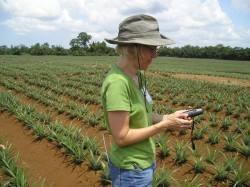Leslie Sherman
- W. Alton Jones Professor of Chemistry & Environmental Science; Chair of the Chemistry Department

Education
- B.A. Carleton College
- M.S.C.E. University of Minnesota
- Ph.D. University of Wisconsin-Madison
Teaching
My own experience as a college student at a small liberal arts college like Washington College, inspired me to become a teacher at a small school. My first teaching experience was actually as a Peace Corp Volunteer in West Africa, where I taught Chemistry and Physics. Currently, I have a dual appointment in Chemistry and Environmental Science and Studies here at Washington College. I teach Quantitative Chemical Analysis and two Environmental Chemistry classes, given my expertise in the air, water and soil chemistry of natural and polluted environments.
Environmental Chemistry - Course description
In Environmental Chemistry we study the reactions controlling the cycling of both natural chemical species and anthropogenic pollutants in the water, soil and air environments of our earth system. The chemical processes operating in the natural environment, including acid-base, complexation, redox, photochemical and biotic degradation phenomena are examined. Throughout the course, the chemistry underlying current issues of water, soil and air pollution are studied. In the laboratory portion of the class, we investigate the water quality of local water bodies, including the Chester River, as well as analyze car exhaust from automobiles.
During her sabbatical in Costa Rica, chemistry Professor Leslie Sherman studied how intensive agriculture affects tropical soil, and witnessed one of nature’s most magical events.
It’s a hike from Chestertown, Md., to Guapilis, Costa Rica—about 2,100 miles in fact—and the long, flat fields of Maryland’s Eastern Shore are a world away from the lush landscape and tropical fecundity of Central America. Connection, though, is all about common ground, and Professor Leslie Sherman found plenty of that during her recent sabbatical at EARTH University.
Sherman, Washington College’s W. Alton Jones Associate Professor of Chemistry and director of the Environmental Science and Studies program, is a soil scientist, and much of her work at WC has focused on the native grassland restoration project at the Chester River Field Research Station at Chino Farms. There, she examined how changing the land use from traditional agriculture (corn, soybeans) to native grasses affected soil long-term. Traveling to Costa Rica on a faculty enhancement grant, she studied the same issue, only here the crop was pineapples, and the question focused more closely on a single intense land use over time.
“I’ve always wanted to study a tropical system both because the soils are fascinating and because the agriculture is so different,” Sherman says. She based her work out of EARTH University, which offers students from Latin America, the Caribbean, Africa, and Asia a program in agricultural sciences and natural resources management. Three students from Mozambique, Ecuador, and Bolivia helped Sherman with her with lab and field work.
Pineapples are a major crop, and Sherman was curious how the plants manage to grow so well on highly weathered, nutrient-poor soils, especially considering how densely planted they are—about 75,000 plants per hectare (2.5 acres)—and how intensely they’re managed with pesticides and fertilizers. “In three years you get two whole crops. So it’s incredibly productive. I was interested in how these decades of highly intensive agriculture are impacting the soil quality. It’s still productive, but is anything happening in the long run?”
Sherman studied one plantation, taking samples in plots five to seven years old and plots 25 years old, as well as samples from a bordering pasture, a remnant of a previous land use. She found that the organic matter, which provides structure for the plants, nutrients, and helps keep the soil moist, was not degraded in the cultivated plots, probably because after every planting cycle, the growers chop all the residue plant material and mix it into the soil. “After every crop they did this, and since it was the tropics it gets incorporated very quickly.” However, the older plot showed a build-up of acidity being held in the soil, which in the long run may prove to be a problem.
Sherman also explored some of Costa Rica’s world-famous biological diversity and natural beauty. One of her favorite trips was to Tortuguero National Park, where she witnessed one of nature’s most miraculous and mysterious events, the arribada, or arrival, of female green sea turtles. After traveling thousands of miles through unknown reaches of the sea, for one night they come ashore to the beach where they themselves hatched to lay their eggs in the sand. The spectacle, she says, “was just amazing.”
Much of what she learned will make its way into her classes, from discussions about the tension between conservation of biodiversity and the necessity of agricultural operations, to the potential benefits of ecotourism to help protect endangered species such as sea turtles.
-
Sherman, L.A. and K. Brye. 2019. Soil chemical property changes in response tolong-term pineapple cultivation in Costa Rica. Agrosyst. Geosci. Environ. Vol 2, Issue 1. https://doi.org/10.2134/age2019.07.0052